Apollo 11 stones - Study guides, Class notes & Summaries
Looking for the best study guides, study notes and summaries about Apollo 11 stones? On this page you'll find 25 study documents about Apollo 11 stones.
All 25 results
Sort by

-
AP Art History 250 questions with correct answers
- Exam (elaborations) • 170 pages • 2023
- Available in package deal
-
- $14.49
- + learn more
1. Apollo 11 Stones CORRECT ANSWER Form: -stones with charcoal drawings of animals -geometric designs - 4-5" Function: - depict animals =some of world's oldest works of art Content: - animal figures with human legs added on probably later Context: - found in Apollo 11 caves in Namibia -probably were made about 25500 BCE (oldest representational art in Africa) and buried in these caves -named because it was discovered at the time of the Apollo 11 moon landing 2. Great Hall of t...
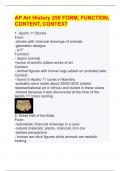
-
AP Art History 250 FORM, FUNCTION, CONTENT, CONTEXT
- Exam (elaborations) • 182 pages • 2024
- Available in package deal
-
- $16.99
- + learn more
AP Art History 250 FORM, FUNCTION, CONTENT, CONTEXT 1. Apollo 11 Stones Form: -stones with charcoal drawings of animals -geometric designs - 4-5" Function: - depict animals =some of world's oldest works of art Content: - animal figures with human legs added on probably later Context: - found in Apollo 11 caves in Namibia -probably were made about 25500 BCE (oldest representational art in Africa) and buried in these caves -named because it was discovered at the time of the Apoll...

-
ap art history: midterm: multiple choice questions and answers 2023
- Exam (elaborations) • 22 pages • 2023
- Available in package deal
-
- $13.99
- 1x sold
- + learn more
ap art history: midterm: multiple choice questions The emphasis on the anatomy of women portrayed in Prehistoric art suggests early man's interest in a. gold and jewels b. health and fertility c. athletic competitions d. the domestication of animals - b. health and fertility b. mortise and tenon construction - To ensure stability of a structural form, an architectural innovation utilized at Stonhenge was the use of a. squinches to support large sarsen lintels b. moritse and tenon c...
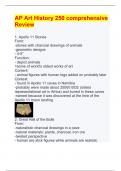
-
AP Art History 250 comprehensive Review
- Exam (elaborations) • 182 pages • 2024
- Available in package deal
-
- $12.99
- + learn more
AP Art History 250 comprehensive Review 1. Apollo 11 Stones Form: -stones with charcoal drawings of animals -geometric designs - 4-5" Function: - depict animals =some of world's oldest works of art Content: - animal figures with human legs added on probably later Context: - found in Apollo 11 caves in Namibia -probably were made about 25500 BCE (oldest representational art in Africa) and buried in these caves -named because it was discovered
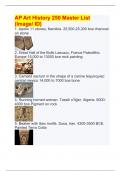
-
AP Art History 250 Master List (Image/ ID)
- Exam (elaborations) • 57 pages • 2024
- Available in package deal
-
- $14.99
- + learn more
AP Art History 250 Master List (Image/ ID) 1. Apollo 11 stones, Namibia. 25,500-25,300 bce charcoal on stone 2. Great Hall of the Bulls Lascaux, France Paleolithic Europe 15,000 to 13000 bce rock painting 3. Camelid sacrum in the shape of a canine tequixquiac central mexico 14,000 to 7000 bce bone
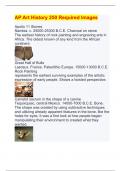
-
AP Art History 250 Required Images
- Exam (elaborations) • 100 pages • 2024
- Available in package deal
-
- $12.99
- + learn more
Apollo 11 Stones Nambia. c. B.C.E. Charcoal on stone The earliest history of rock painting and engraving arts in Africa. The oldest known of any kind from the African continent. Great Hall of Bulls Lascaux, France. Paleolithic Europe. B.C.E. Rock Painting represents the earliest surviving examples of the artistic expression of early people. Shows a twisted perspective.
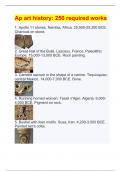
-
Ap art history: 250 required works
- Exam (elaborations) • 52 pages • 2024
- Available in package deal
-
- $16.99
- + learn more
Ap art history: 250 required works 1. Apollo 11 stones. Nambia, Africa. 25,500-25,300 BCE. Charcoal on stone. 2. Great Hall of the Bulls. Lascaux, France. Paleolithic Europe. 15,000-13,000 BCE. Rock painting. 3. Camelid sacrum in the shape of a canine. Tequixquiac, central Mexico. 14,000-7,000 BCE. Bone.
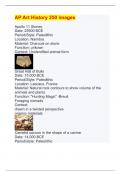
-
AP Art History 250 images
- Exam (elaborations) • 173 pages • 2024
- Available in package deal
-
- $12.99
- + learn more
AP Art History 250 images Apollo 11 Stones Date: 25500 BCE Period/Style: Paleolithic Location: Namibia Material: Charcoal on stone Function: unkown Context: Unidentified animal form

-
AP Art History 250 Comprehensive Exam.
- Exam (elaborations) • 147 pages • 2024
- Available in package deal
-
- $13.99
- + learn more
1. Apollo 11 Stones - correct answer Form: -stones with charcoal drawings of animals -geometric designs - 4-5" Function: - depict animals =some of world's oldest works of art Content: - animal figures with human legs added on probably later Context: - found in Apollo 11 caves in Namibia -probably were made about 25500 BCE (oldest representational art in Africa) and buried in these caves -named because it was discovered at the time of the Apollo 11 moon landing 2. Great Hall of...

-
AP Art History 250 Written Exam Question With 100% Verified Answers .
- Exam (elaborations) • 147 pages • 2024
- Available in package deal
-
- $14.99
- + learn more
1. Apollo 11 Stones - correct answer Form: -stones with charcoal drawings of animals -geometric designs - 4-5" Function: - depict animals =some of world's oldest works of art Content: - animal figures with human legs added on probably later Context: - found in Apollo 11 caves in Namibia -probably were made about 25500 BCE (oldest representational art in Africa) and buried in these caves -named because it was discovered at the time of the Apollo 11 moon landing 2. Gr...

Did you know that on average a seller on Stuvia earns $82 per month selling study resources? Hmm, hint, hint. Discover all about earning on Stuvia


